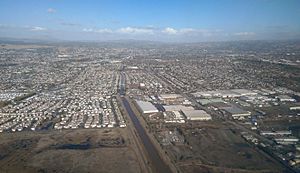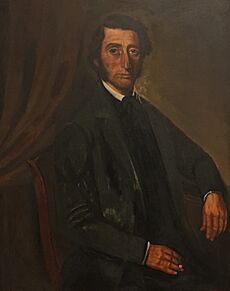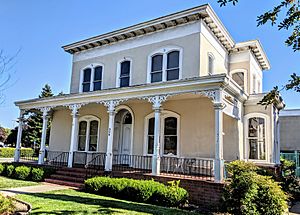San Lorenzo, California facts for kids
Quick facts for kids
San Lorenzo
|
|
|---|---|
 |
|

Location in Alameda County and the state of California
|
|
| Country | |
| State | |
| County | Alameda |
| Area | |
| • Total | 2.770 sq mi (7.17 km2) |
| • Land | 2.763 sq mi (7.16 km2) |
| • Water | 0.007 sq mi (0.02 km2) 0.24% |
| Elevation | 36 ft (11 m) |
| Population
(2020)
|
|
| • Total | 29,581 |
| • Density | 10,679.1/sq mi (4,123.2/km2) |
| Time zone | UTC-8 (Pacific (PST)) |
| • Summer (DST) | UTC-7 (PDT) |
| ZIP code |
94580
|
| Area code(s) | 510, 341 |
| FIPS code | 06-68112 |
| GNIS feature IDs | 232433, 1659583, 2409260 |
San Lorenzo is a community in Alameda County, California. Its name means "St. Lawrence" in Spanish. It is located in the East Bay part of the San Francisco Bay Area. In 2020, about 29,581 people lived here.
San Lorenzo is an unincorporated community. This means it is not an official city with its own local government. Instead, it is part of the larger county. It sits along the banks of San Lorenzo Creek. The area was first called Squattersville in 1851. Later, it was renamed San Lorenzo.
In 1944, a company called The David D. Bohannon Company started building San Lorenzo Village. This project was for the U.S. Navy. It became one of the first planned communities in the country. This means it was designed with specific areas for schools, churches, parks, and shops. Bohannon's building methods, called the "California method," were used in other famous developments later on.
Contents
History of San Lorenzo
San Lorenzo is located on an old route called El Camino Viejo. This land was once part of two large Mexican land grants. One was Rancho San Lorenzo, given to Guillermo Castro in 1841. The other was Rancho San Leandro, given to José Joaquin Estudillo in 1842.
During the California Gold Rush, some early settlers lived here. They were called "squatters" because they settled on land without official ownership. This area was informally known as Squatterville.
The first post office in San Lorenzo opened in 1854. Many early residents are buried in the San Lorenzo Pioneer Cemetery. This includes Moses Wicks, who brought oysters to San Leandro Bay. The Hayward Area Historical Society helps take care of the cemetery.
From the mid-1800s to the mid-1900s, San Lorenzo was mostly farmland. It was an important place for growing fruits and flowers.
Building San Lorenzo Village
In 1944, The David D. Bohannon Company began building San Lorenzo Village. This project was for workers in the East Bay's war industries. It included many homes with two or three bedrooms. San Lorenzo Village was one of the first planned communities in the United States. It had special areas set aside for schools, churches, parks, and shopping centers.
Bohannon's new building methods, called the "California method," involved pre-cutting materials. These methods were later used in other large developments, like Levittown, Pennsylvania. Home construction continued into the 1950s. This helped house the many people moving to the area.
The San Lorenzo Village housing project was the largest privately funded housing project on the West Coast during World War II. The San Lorenzo Shopping Center was also one of the country's first planned community shopping centers. It was home to the first Mervyn's Department Store.
Changes Over Time
The original homes in San Lorenzo Village had rules about who could buy them. These rules, called "racially restrictive covenants," meant that only white owners could purchase homes. Sales brochures from the 1950s even said these rules protected property values.
However, in 1948, the Supreme Court case Shelley v. Kraemer made it illegal to enforce these kinds of restrictions in court. This meant that while the old rules might still be written on property deeds, they could not be used to stop people of color from buying homes. Even after this ruling, some groups still tried to prevent non-white owners.
Geography of San Lorenzo
San Lorenzo covers about 2.8 square miles (7.3 square kilometers). Most of this area is land, with a small amount of water. San Lorenzo Creek flows through parts of the community.
San Lorenzo is located between two cities. To the north is San Leandro, and to the south is Hayward.
Population Information
This section shares facts about the people who live in San Lorenzo.
Population in 2010
In 2010, the 2010 United States Census counted 23,452 people living in San Lorenzo. There were 7,425 households, and 5,792 families. Most people lived in homes, with only a small number in group living situations.
The population included people from many different backgrounds. About 47.4% were White, 4.8% African American, 1.0% Native American, 21.6% Asian, and 0.8% Pacific Islander. About 17.9% were from other races, and 6.5% were from two or more races. A large group, 37.7%, identified as Hispanic or Latino.
About 40% of households had children under 18. Most households (56.7%) were married couples. The average household had 3.15 people, and the average family had 3.54 people.
The population was spread out by age. About 24.2% were under 18, and 12.7% were 65 or older. The average age was 37.9 years. For every 100 females, there were about 95 males.
Most homes (75%) were owned by the people living in them. The rest were rented.
Population in 2000
In the 2000 United States Census, there were 21,898 people in San Lorenzo. There were 7,500 households and 5,677 families.
About 34.7% of households had children under 18. Most households (58.1%) were married couples. The average household size was 2.92 people, and the average family size was 3.34 people.
The population was also spread out by age in 2000. About 25.2% were under 18, and 16.0% were 65 or older. The average age was 38 years. For every 100 females, there were about 94 males.
The median income for a household was $66,170. For a family, it was $71,787. The average income per person was $21,922. A small percentage of families (3.7%) and people (5.4%) lived below the poverty line.
Schools in San Lorenzo
The San Lorenzo Unified School District serves the community. This school district was started in 1865.
Images for kids
See also
 In Spanish: San Lorenzo (California) para niños
In Spanish: San Lorenzo (California) para niños






